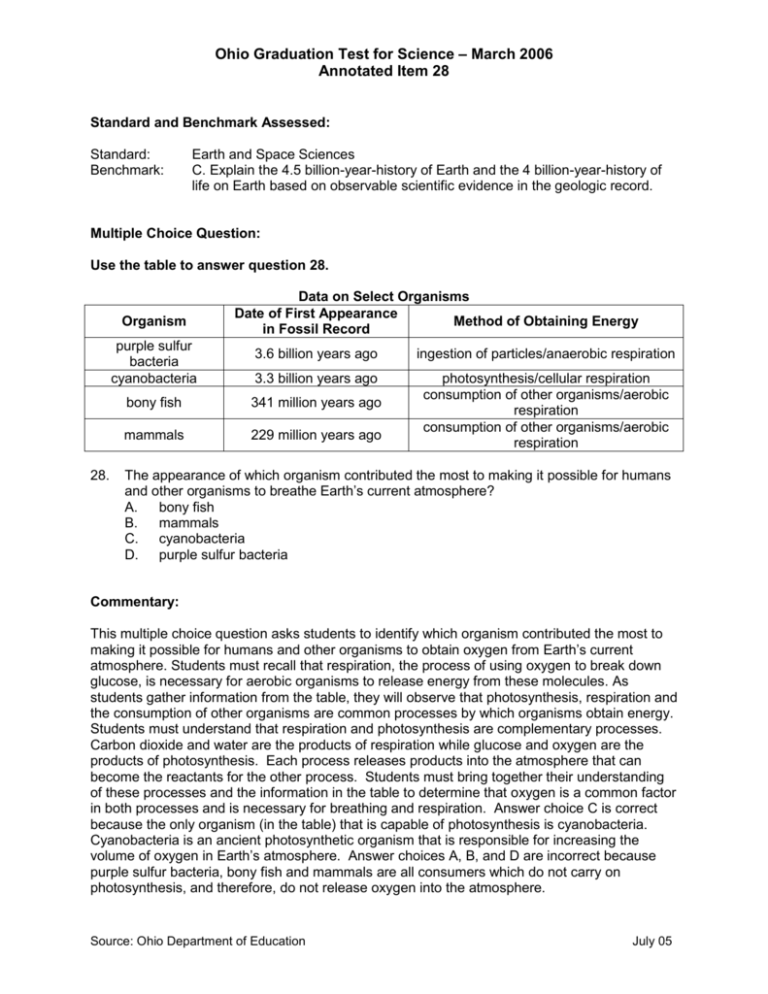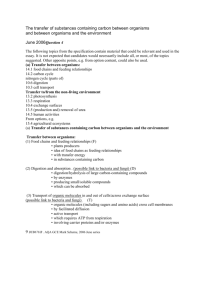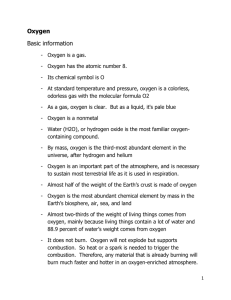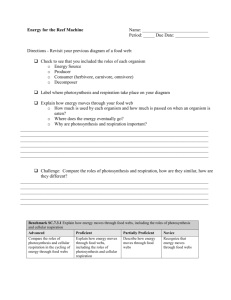Add Header – ODE Apple, no shaping - ODE IMS
advertisement

Ohio Graduation Test for Science – March 2006 Annotated Item 28 Standard and Benchmark Assessed: Standard: Benchmark: Earth and Space Sciences C. Explain the 4.5 billion-year-history of Earth and the 4 billion-year-history of life on Earth based on observable scientific evidence in the geologic record. Multiple Choice Question: Use the table to answer question 28. Organism purple sulfur bacteria cyanobacteria 28. Data on Select Organisms Date of First Appearance Method of Obtaining Energy in Fossil Record 3.6 billion years ago ingestion of particles/anaerobic respiration 3.3 billion years ago photosynthesis/cellular respiration consumption of other organisms/aerobic respiration consumption of other organisms/aerobic respiration bony fish 341 million years ago mammals 229 million years ago The appearance of which organism contributed the most to making it possible for humans and other organisms to breathe Earth’s current atmosphere? A. bony fish B. mammals C. cyanobacteria D. purple sulfur bacteria Commentary: This multiple choice question asks students to identify which organism contributed the most to making it possible for humans and other organisms to obtain oxygen from Earth’s current atmosphere. Students must recall that respiration, the process of using oxygen to break down glucose, is necessary for aerobic organisms to release energy from these molecules. As students gather information from the table, they will observe that photosynthesis, respiration and the consumption of other organisms are common processes by which organisms obtain energy. Students must understand that respiration and photosynthesis are complementary processes. Carbon dioxide and water are the products of respiration while glucose and oxygen are the products of photosynthesis. Each process releases products into the atmosphere that can become the reactants for the other process. Students must bring together their understanding of these processes and the information in the table to determine that oxygen is a common factor in both processes and is necessary for breathing and respiration. Answer choice C is correct because the only organism (in the table) that is capable of photosynthesis is cyanobacteria. Cyanobacteria is an ancient photosynthetic organism that is responsible for increasing the volume of oxygen in Earth’s atmosphere. Answer choices A, B, and D are incorrect because purple sulfur bacteria, bony fish and mammals are all consumers which do not carry on photosynthesis, and therefore, do not release oxygen into the atmosphere. Source: Ohio Department of Education July 05 Ohio Graduation Test for Science – March 2006 Annotated Item 28 The question is classified as Recalling / Identifying Accurate Science because the task requires students to recall details of the processes of respiration and photosynthesis and identify the organism capable of releasing oxygen into the atmosphere billions of years ago. Performance Data: The 6Ohio Graduation Test was 52%. Keywords: photosynthesis, oxygen, atmosphere, respiration Source: Ohio Department of Education July 05








